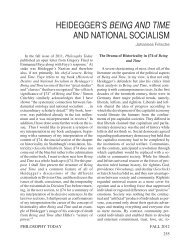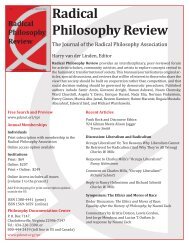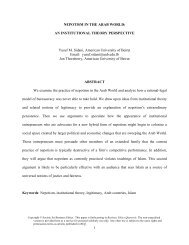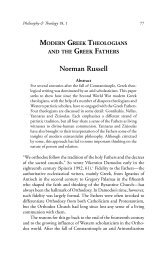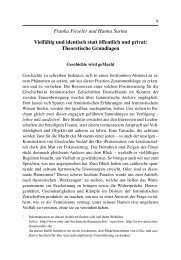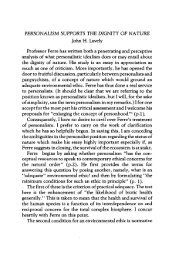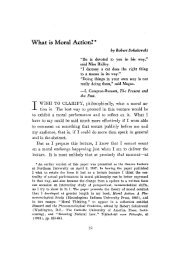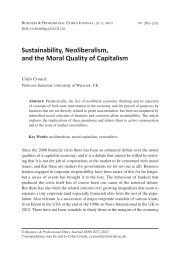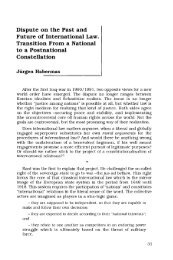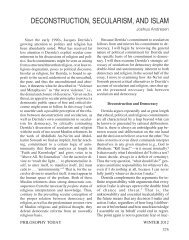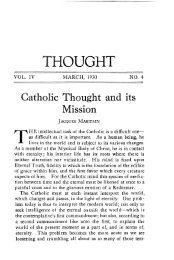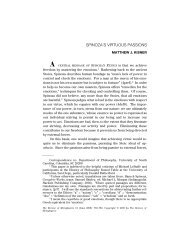Becoming Gods by Becoming God's: Augustine's Mystagogy of ...
Becoming Gods by Becoming God's: Augustine's Mystagogy of ...
Becoming Gods by Becoming God's: Augustine's Mystagogy of ...
Create successful ePaper yourself
Turn your PDF publications into a flip-book with our unique Google optimized e-Paper software.
Augustinian Studies 39:1 (2008) 61–74<br />
<strong>Becoming</strong> <strong>Gods</strong> <strong>by</strong> <strong>Becoming</strong> God’s:<br />
Augustine’s <strong>Mystagogy</strong> <strong>of</strong> Identification<br />
David Vincent Meconi, S.J.<br />
Saint Louis University<br />
Introduction<br />
In his autobiographical commentary on the Confessions the late Jean-François<br />
Lyotard relied on Augustine to envision how every human person remains a “creature<br />
at work, working for its conversion, one who does not stop turning toward the true<br />
light, so fearful is it <strong>of</strong> falling into delusion, into hallucination—a creature laments<br />
the anxiety <strong>of</strong> being abandoned to the night. Temporality blows death over things and<br />
signs.” 1 Lyotard rightly understood how Augustine approached the temporal world<br />
<strong>of</strong> “things and signs” with both rapt attention and a fearful mistrust, with both a need<br />
to engage created goods as well as an apprehension lest he get too close. For the<br />
great Bishop <strong>of</strong> Hippo realized more intimately than most how the world can either<br />
drag those made in God’s image down into the skeins <strong>of</strong> carnality, or can iconically<br />
bespeak God’s goodness and lift the rational mind to praise <strong>of</strong> its creator.<br />
Such ambiguity makes the following homiletic trope all the more worthy <strong>of</strong><br />
attention. In this essay I wish to examine a very curious and intriguing metaphor:<br />
Augustine’s exhortation that the faithful are to become the things <strong>of</strong> God. Far from<br />
the standard pastoral encouragement to become Christ-like or to take on certain<br />
virtues, he instead prompts his hearers to become the inanimate objects already<br />
revered <strong>by</strong> the Christian community. Some examples <strong>of</strong> this pattern include:<br />
1. Jean-François Lyotard, The Confession <strong>of</strong> Augustine, trans., Richard Beardsworth (Palo Alto, CA:<br />
Stanford University Press, 2000) 45–46.<br />
61
MECONI: BECOMING GODS BY BECOMING GOD’S<br />
Love what you do, imitate what you celebrate, and become what you praise /<br />
ama quod agis, imitare quod celebras, fac quod laudas. 2<br />
Be what you proclaim—and you will be his praise if you live rightly / uos estote<br />
quod dicatis. laus ipsius estis, si bene uiuatis. 3<br />
Be gold . . . be God’s riches / esto aurum . . . esto diuites de deo. 4<br />
When lifted to him, the heart <strong>of</strong> the faithful is God’s altar / cum ad illum surusm<br />
est, eius est altare cor nostrum. 5<br />
Be valleys / conualles estote. 6<br />
Be chrism / oleum estote. 7<br />
In secret become God’s living tree / esto arbor uiua in occulto. 8<br />
Become Jerusalem / estote ierusalem. 9<br />
Be the temple <strong>of</strong> God first, because in that temple he will readily hear you praying<br />
/ sed prius esto templum dei , quia ille in templo suo exaudiet orantem. 10<br />
Augustine preaches for his hearers to become gold, chrism, God’s living trees,<br />
or his holy city Jerusalem. The brilliance <strong>of</strong> the golden chalice, the lush fertility<br />
<strong>of</strong> the earth’s valleys, or the beauty <strong>of</strong> the Christian temple all play a pedagogical<br />
role in showing the faithful how their lives must be formed.<br />
While this list is far from exhaustive, there is already enough here to ascertain a<br />
definite pattern. First, such constructions almost always appear within the liturgy;<br />
second, almost always toward the end <strong>of</strong> a homily; and they, finally, usually appear<br />
in one <strong>of</strong> three ways: with the direct plural imperative estote, with the hortatory<br />
subjunctive simus, or with the indicative estis followed <strong>by</strong> a si or a cum clause, thus<br />
implying that one must first meet some particular condition before a transformation<br />
can take place.<br />
This taxonomy as well as the context <strong>of</strong> each statement is not unimportant.<br />
These are ecclesial exhortations, <strong>of</strong>fered only to the community <strong>of</strong> the faithful so<br />
2. S. 345.5; PL 46.979. Unless otherwise noted, all translations are my own.<br />
3. S. 34.6; PL 38.211.<br />
4. S. 62.12; PL 38.420.<br />
5. Ciu. Dei 10.3; CCL 47.275.<br />
6. En. Ps. 103. exp. 2.11; CCL 40.1498.<br />
7. S. 19.6; PL 38.137.<br />
8. S. 25A.1.<br />
9. En. Ps. 147.7; CCL 40.2144.<br />
10. Jo. eu. tr. 15.25; CCL 36.161.<br />
62
MECONI: BECOMING GODS BY BECOMING GOD’S<br />
as to deepen their own lives with God. Such metaphors point to a mystagogy <strong>of</strong><br />
identification: a mystagogy because it is the great Bishop’s way <strong>of</strong> leading those<br />
who already bear the name <strong>of</strong> Christ into a more active spiritual and liturgical participation,<br />
an identification because it is based on ontological and epistemological<br />
preconditions which render signs efficacious only when they are assimilated into<br />
individual human lives. Augustine is accordingly striving to lead the faithful into<br />
a deeper charity <strong>by</strong> inviting his congregation not merely to gaze upon the images<br />
found in scripture or to watch the liturgy from a passive distance but actually to<br />
become such. This spiritual pedagogy asserts that true praise occurs only when<br />
Christian images and symbols are drawn into the human person as he or she is<br />
simultaneously drawn into the divine.<br />
But what is implied <strong>by</strong> such identification? How can worshippers become<br />
the objects they encounter in the Christian narrative? This essay maintains that<br />
Augustine’s insistence that the faithful are to become the things <strong>of</strong> God is motivated<br />
<strong>by</strong> three central convictions. The first is the iconic nature <strong>of</strong> the cosmos.<br />
The visible world betokens and bespeaks its invisible creator. The second is<br />
Augustine’s own understanding <strong>of</strong> the role and purpose <strong>of</strong> signs which contain<br />
and indicate higher realities. He knew how God educates his people through visible<br />
things so they may better apprehend the invisible. 11 The third is his theory <strong>of</strong>,<br />
what I call, a sympathetic diligence, Augustine’s deep appreciation <strong>of</strong> how love<br />
transforms the lover into what he or she beholds. By way <strong>of</strong> conclusion this essay<br />
then raises the <strong>of</strong>ten neglected heart <strong>of</strong> Augustine’s soteriology—humanity’s<br />
becoming gods.<br />
Creation’s Doxological Deiformity<br />
In rendering these homiletic lines intelligible, the iconic nature <strong>of</strong> the cosmos<br />
must be examined first. All creation is doxologically deiform in that its very existence<br />
points to a self-sufficient and benevolent Maker. Furthermore, all creation praises<br />
God <strong>by</strong> manifesting, however faint, the divine’s qualities in space and time. For<br />
Plato, the visible cosmos was the product <strong>of</strong> non-jealous divinity: since Goodness<br />
itself can not admit <strong>of</strong> any jealousy (fqovno~), it was fitting that God generate the<br />
visible world. Accordingly, this God is not only free and generous, he actually wills<br />
all things to be like him. 12 In similar fashion, Plotinus muses how the earth can be<br />
heard to say, “A god made me, and I came from him perfect above all living things<br />
11. Cf. en. Ps. 44.5.<br />
12. Cf. Timaeus 29D–30A; see also the famous definition <strong>of</strong> the visible order as the moving image <strong>of</strong><br />
eternity later at Timaeus 37D.<br />
63
MECONI: BECOMING GODS BY BECOMING GOD’S<br />
. . . all things participate in being, others in life, others more fully in sense-perception,<br />
others in reason, and others in the fullness <strong>of</strong> life.” 13<br />
Such is the background to Augustine’s own sense <strong>of</strong> the universe, beautifully<br />
expressed in his own questioning <strong>of</strong> the cosmos: “I put my question to the earth,<br />
and it replied, ‘I am not he.’ . . . And to all things which stood around the portals <strong>of</strong><br />
my flesh I said, ‘Tell me <strong>of</strong> my God. You are not he, but tell me something <strong>of</strong> him.’<br />
Then they lifted up their mighty voices and cried, ‘He made us.’ My questioning<br />
was my attentive spirit, and their reply, their beauty—Interrogatio mea intentio<br />
mea et responsio eorum, species eorum.” 14 This iconic role <strong>of</strong> contingent being is<br />
important because as Augustine came to understand it, the created order can now<br />
speak to us <strong>of</strong> God. 15<br />
The ultimate purpose <strong>of</strong> every creature is to raise the rational soul to the divine:<br />
a visible good is understood to be essentially a participant in God and its iconic role<br />
within the economy is precisely what makes it worth gazing upon, worth knowing.<br />
Only the correctly-ordered soul can allow the transparency <strong>of</strong> creation. For<br />
those who engage the world around them in such a rational and religious way (pie<br />
quaerunt), creatures point to the Triune God; those whose perception is blinded<br />
<strong>by</strong> pride, however, end up worshiping the creature instead <strong>of</strong> the creator. 16 Such an<br />
inversion is also explained as a perversion: <strong>by</strong> settling on the creature, the deceived<br />
soul confuses material goods with God. This type <strong>of</strong> soul fails to soar upward to<br />
the divine but falls under the very bodies over which it is to have dominion, thus<br />
confusing these visible creatures with their craftsman. 17<br />
13. Enneads III.2.3; trans., A. H. Armstrong, Plotinus 3 (Cambridge: Loeb Classical Library, 1980)<br />
53.<br />
14. Conf. 10.6.9; Maria Boulding, Confessions (Hyde Park: New City Press) I/1, 242–243(hereafter<br />
WSA and series and volume number); cf. s. 241.2 (411 A.D.) where this phrase is slightly altered:<br />
‘pulchritudo eorum, confessio eorum’; PL 38.1134.<br />
15. Pierre Courcelle, Recherches sur les Confessions de saint Augustin (Paris: Boucard, 1950) 98–<br />
103, argues that Augustine was present to hear Ambrose’s preaching on Genesis and would have<br />
there picked up on the triadic structure <strong>of</strong> creation. Drawing from Paul’s a quo, per quem, in quo<br />
(Rom 11:36), Ambrose delineates the creative act as one <strong>of</strong> beginning and origin (prinicipium et<br />
origo), the continuation <strong>of</strong> all being (continuatio), and the end for which all creatures have been<br />
brought into being (fi nis); Hexameron, 1.5.19; CSEL 32.16. Next, arriving in Northern Africa,<br />
Augustine comes to incorporate the triad at Wisdom 11:21 as a suitable way to identify the Father<br />
with Measure, the Son with Number, and the Holy Spirit with Order, first appearing at Gn. adu.<br />
Man. 1.16.26 in 388/89.<br />
16. Conf. 5.3.5: ‘[E]t conuertunt ueritatem tuam in mendacium et colunt et seruiunt creaturae potius<br />
quam creatori.’; CCL 27.59.<br />
17. Uer. rel. 36.67: “Nam quoniam opera magis quam artificem atque ipsam artem dilexerunt, hoc errore<br />
puniuntur, ut in operibus artificem artemque conquirant, et cum inuenire nequiuerint—Deus<br />
64
MECONI: BECOMING GODS BY BECOMING GOD’S<br />
In no way is this plunge into the visible order the fault <strong>of</strong> the created sign but<br />
<strong>of</strong> the disordered soul. Unlike the Manichean cosmology, creatures in the world <strong>of</strong><br />
Christianity are morally neutral in that they can either direct humans toward the<br />
divine or can enmesh them in the allure <strong>of</strong> mortal transience. The soul must never<br />
regard creatures as marvels absolutely in se but in the Augustinian cosmos they are<br />
to be iconic indicators <strong>of</strong> the divine. Signs are to show the mind something beyond<br />
themselves. 18 Let us now focus more particularly on this interaction between soul<br />
and sign. How do creatures lift the soul to God and how does Augustine describe<br />
this process?<br />
<strong>Becoming</strong> Living Signs<br />
The diaphanous nature <strong>of</strong> creatures compels Augustine to be very cautious with<br />
regard to what objects he displays as worthy <strong>of</strong> observation and, in this way, his<br />
understanding <strong>of</strong> signs emerges as the second crucial component <strong>of</strong> the exhortations<br />
under consideration. As bishop and pastor, Augustine is understandably discerning<br />
with regard to what objects he holds in front <strong>of</strong> his flock for their attention and<br />
emulation. He understands the power <strong>of</strong> the sympathy, the effect <strong>of</strong> the affection,<br />
when a human knower encounters an earthly sign. He appreciates how created goods<br />
have the power to transform, always aware <strong>of</strong> the intricate relationship between<br />
knowing, loving, and becoming.<br />
The soul can either strain for that place from which it came or it can settle<br />
for visible goods. This latter alternative is a matter <strong>of</strong> isolation, disparateness,<br />
and powerlessness, a violation <strong>of</strong> the soul’s highest nature. By losing sight <strong>of</strong> the<br />
proper—that is, iconic—role <strong>of</strong> created goods, the soul accordingly loses itself<br />
and becomes absorbed in the allure <strong>of</strong> materiality. Instead <strong>of</strong> a clear ordering <strong>of</strong><br />
creatures unto God, in this fallen state, the soul becomes confused with what it<br />
is to master. It has loved wrongly and has thus become distorted. Plotinus would<br />
explain it thus:<br />
Now when a soul . . . does not look towards the intelligible (to; nohto;n), it has<br />
become a part and is isolated and weak and fuses and looks towards a part and in its<br />
separation from the whole it embarks on one single thing and flies from everything<br />
else . . . applying itself to and caring for things outside and is present and sinks<br />
deep into the individual part. 19<br />
enim non corporalibus sensibus subiacet, sed ipsi menti supereminet—ipsa opera existiment esse<br />
et artem et artificem.”; CCL 32.231.<br />
18. Cf. doc. Chr. 2.2.1<br />
19. Enneads, IV.8.4; Armstrong, 4.408–409<br />
65
MECONI: BECOMING GODS BY BECOMING GOD’S<br />
Augustine clearly echoes this ability <strong>of</strong> the individual soul to lose its way, finding<br />
itself not only forgetful <strong>of</strong> its divine image but conforming itself to those things<br />
which should remain below it. That is, when the human soul turns away from God,<br />
it becomes confused with lower goods; loving creatures instead <strong>of</strong> their creator, the<br />
soul becomes fused with the world.<br />
Left on its own the human soul is unable to interact rightly with the barrage<br />
<strong>of</strong> external goods surrounding it. Augustine’s strategy <strong>of</strong> being removed from this<br />
morass is the Holy Spirit. The Spirit <strong>of</strong> God as unifier and gift possesses the particular<br />
responsibility to ensure that the human soul remains above the rest <strong>of</strong> the<br />
visible order and hence united with the divine: “It is love which conforms us to<br />
God and thus conformed and configured to God and cut <strong>of</strong>f from this world, we are<br />
not confounded with the things which ought to be subject to us. This is done only<br />
through the Holy Spirit.” 20 When cutting himself <strong>of</strong>f from the divine, the human<br />
person attaches himself to created goods and consequently falls below even that<br />
over which he was intended to dwell. In the Holy Spirit, however, the faithful are<br />
given the requisite power to live through visible creatures and to rise above them<br />
so as to be united to the divine.<br />
The Holy Spirit not only gathers in the fragmented because sinful soul, he frees<br />
human nature from its self-imposed identification with mortal goods <strong>by</strong> uniting it<br />
to the Triune life, “gluing” us to the Son at the Father’s right hand. Such agency is<br />
encountered in Augustine’s commentary on Ps 62 where gluten is identified with<br />
the Holy Spirit, the love <strong>of</strong> God: “Where are we to find the strong glue? The glue<br />
is charity. Have charity in you and it will glue your soul into place, following God.<br />
Not with God, but behind God, so that he goes ahead and you follow.” 21 The Holy<br />
Spirit properly orders creation <strong>by</strong> raising those in whom he dwells above the rest<br />
<strong>of</strong> the visible order, attaching them to God in a bond which allows human persons<br />
to appropriate the divine life.<br />
Conversely, without the Holy Spirit, the human person risks knowing carnally<br />
(carnaliter sapitur) and therefore risks becoming one with lower sensibles. This<br />
is a threat every incarnate soul faces living in a world surrounded <strong>by</strong> icons which<br />
potentially lead to God or can prove to be ensnaring idols. That is, when the soul<br />
loves God through the signifier, the soul becomes divine, when the soul loves the<br />
20. Mor. 1.13.23: “Fiet ergo per caritatem ut conformemur Deo et ex eo conformati atque figurati et<br />
circumcisi ab hoc mundo non confundamur cum his quae nobis debent esse subiecta. Fit autem<br />
hoc per spiritum sanctum.”; CSEL 90.27.<br />
21. En. Ps. 62.17; Boulding, Expositions (WSA III/17), 243. Cf. ‘The Glue Itself Is the Charity: Ps<br />
62:9 in Augustine’s Thought,’ Collectanea Augustiniana: Pres<strong>by</strong>ter Factus Sum, ed., J. Lienhard,<br />
E. Mueller, and R. Teske (New York: Peter Lang, 1993) 375–384.<br />
66
MECONI: BECOMING GODS BY BECOMING GOD’S<br />
sign instead <strong>of</strong> God, the soul is made bestial. One knows carnally when one mistakes<br />
a sign for a thing and consequently falls to the level <strong>of</strong> beasts <strong>by</strong> becoming fixated<br />
on the visible sign. Unable to see through signs and see their creator is the death <strong>of</strong><br />
the soul (mors animae), and this soul now finds itself unable to drink in the eternal<br />
light. As long as the believer sees the Sabbath as another day <strong>of</strong> the week or as<br />
long as he thinks only <strong>of</strong> bloodied victims when he hears the term sacrifi cium, he<br />
remains wretched (miserabilis). 22<br />
How different is this kind <strong>of</strong> admonition when compared to those instances<br />
where the faithful are encouraged to become Sabbath, to become sacrifice:<br />
We ourselves are God’s city, his most brilliant and eminent sacrifice / Huius<br />
autem praeclarissimum atque optimum sacrificium nos ipsi sumus, hoc est ciuitas<br />
eius. 23<br />
We ourselves shall be that seventh day / dies enim septimus etiam nos ipsi<br />
erimus. 24<br />
Believers must cease seeing economic signifiers as external realities only but<br />
must strive to meet God through these signs in such a way that they become, say,<br />
God’s living rest or God’s divine sacrifice.<br />
A spirituality <strong>of</strong> identification is clearly the great Bishop’s pastoral plan for<br />
drawing believers out <strong>of</strong> themselves and into God, through the things <strong>of</strong> God. This<br />
is not a meager aestheticism, not mere decoration covering the Christian experience.<br />
Instead it is a rich confession <strong>of</strong> how God allows himself to be glimpsed in<br />
religious symbols and, as such, these elements <strong>of</strong> the Church’s life bring the faithful<br />
into a sympathetic participation aimed at their divine transformation. Let us now<br />
concentrate on this very Augustinian notion <strong>of</strong> how embracing what one encounters<br />
changes lovers into that which they hold dear.<br />
22. Cf. doc. Chr. 3.5.9: “Cum enim figurate dictum sic accipitur, tamquam proprie dictum sit, carnaliter<br />
sapitur. Neque ulla mors animae congruentius appellatur, quam cum id etiam, quod in<br />
ea bestiis antecellit, hoc est intellegentia, carni subicitur sequendo litteram. Qui enim sequitur<br />
litteram, translata uerba sicut propria tenet neque illud quod proprio uerbo significatur refert ad<br />
aliam significationem. Sed si ‘Sabbatum’ audierit, uerbi gratia, non intellegit nisi unum diem de<br />
septem, qui continuo uolumine repetuntur; et cum audierit ‘Sacrificium,’ non excedit cogitatione<br />
illud quod fieri de uictimis pecorum terrenisque fructibus solet. Ea demum est miserabilis animae<br />
seruitus, signa pro rebus accipere, et supra creaturam corpoream oculum mentis ad hauriendum<br />
aeternum lumen leuare non posse.”; CCL 32.83.<br />
23. Ciu. Dei 19.23; CCL 47.694–695. Note CCL’s typographical error <strong>of</strong> “non” for this “nos” at line<br />
182 on 47.694.<br />
24. Ciu. Dei 22.30; CCL 47.865.<br />
67
MECONI: BECOMING GODS BY BECOMING GOD’S<br />
<strong>Becoming</strong> the Beloved<br />
The Platonic tradition is clear: love attracts, unites, and transforms. 25 Such an<br />
insistence is the third aspect <strong>of</strong> Augustine’s thought which renders these homiletic<br />
exhortations intelligible: his epistemological and volitional presuppositions. First,<br />
the theory <strong>of</strong> knowledge upon which he is reliant explains human interaction with<br />
the visible world as the sympathy between knower and known. The human soul<br />
dwells in an amphibious state between visible goods and the divine, and the innately<br />
undetermined soul is actualized only in the act <strong>of</strong> engaging the world. Again,<br />
<strong>by</strong> turning to Plotinus we can see how his epistemology maintained that through<br />
those bodily organs which are naturally oriented toward visible objects (explained<br />
as a sunecw`n o[ntwn), the soul comes into a certain unity and common affection<br />
(oJmopaqhv~) with objects <strong>of</strong> knowledge. 26 Plotinus taught that in order for the individual<br />
soul to be active in the material order, the soul must find a level <strong>of</strong> unity with<br />
the material order and achieves this <strong>by</strong> translating the disparate physical passions<br />
(e.g., lust, hunger, pain, . . . ) into intelligible noeta. 27 Plotinus realized that through<br />
those bodily organs which are naturally united with visible objects, the soul comes<br />
into a unity and a common affection with the external world as well. In so doing,<br />
a connection between knowing and becoming necessarily arises: we become those<br />
things with which we have intellectual sympathy.<br />
Augustine would have easily learned from “the books <strong>of</strong> the Platonists” how<br />
such instances <strong>of</strong> sense perception involve not only an act <strong>of</strong> knowledge but also an<br />
act <strong>of</strong> becoming. This relationship is expressed at the end <strong>of</strong> the de anima et eius<br />
origine (419/21). Admitting ignorance before an intellectual foe, Vincent Victor,<br />
Augustine is trying to figure out the hidden powers <strong>of</strong> the human mind and their<br />
peculiar ability to shape our own identities. He accordingly asks:<br />
How is it, then, that we are somehow taken away from and denied to ourselves<br />
and then that we are somehow brought back and restored to ourselves? It is as<br />
though we were other persons or in other places, when we looked for and did<br />
not find what we had put in our memory. How is it that we ourselves could not<br />
get at ourselves as if we were somewhere else? And then we do get at ourselves<br />
when we find it. After all, where do we look except in ourselves? And what do we<br />
look for but ourselves, as though we were not in ourselves, and had withdrawn<br />
25. Cf. Plato, Republic 6.485D6; Plotinus, Enneads IV.3.13.<br />
26. Enneads IV.5.1; Armstrong, 4.280.<br />
27. Enneads, I.1.7; Armstrong 1.108. Truth arises when the soul achieves this identification; error<br />
creeps in when the soul fails to raise sensible impressions upwards to the level <strong>of</strong> nohto. and<br />
consequently mistakes sensibles for eternals; cf. Enneads 5.1.5; 5.3.8; 5.3.11; 5.4.2.<br />
68
MECONI: BECOMING GODS BY BECOMING GOD’S<br />
somewhat from ourselves? Do you not see and are you not astonished <strong>by</strong> this<br />
deep puzzle? 28<br />
The pr<strong>of</strong>unditas in question is the connection between epistemological encounters<br />
and personality. Change in identity is hence bound up with the integrity <strong>of</strong> the<br />
human mind. Gathered and recollected, we are present to ourselves; when scattered,<br />
our true self is distant and denied to us.<br />
As subtle as this relationship between knowing and becoming may be for Augustine,<br />
a parallel phenomenon is much more explicit: becoming what one loves.<br />
As early as de ordine (Nov 386–Mar 387) Augustine knew that love consists in the<br />
lover’s longing to be united with the beloved. For what is love, he asks, if not the<br />
reaching out and becoming one with what one loves? 29 Love conforms and couples<br />
lover and beloved. Or as qu. 35 <strong>of</strong> de diuersis quaestionibus a few years later makes<br />
clear, love is a tendency, a movement, and a striving towards another. 30 As such,<br />
Augustine continues, love results in the lover’s being transformed <strong>by</strong> the beloved:<br />
“Because that which is loved necessarily affects the lover from its very own being,<br />
when eternity is loved, it affects the soul <strong>of</strong> the lover with eternity.” 31 In other words,<br />
love not only yearns for, persists and delights in its object, love also configures the<br />
lover to that which he or she loves.<br />
28. An. et or. 4.7.10: “Numquid nos non eramus, quando id cogitabamus? Nec tamen hoc sumus quod<br />
fuimus, quando id cogitare non possumus. Quid est ergo, quod nescio quomodo subtrahimur<br />
negamurque nobis itemque nescio quomodo pr<strong>of</strong>erimur ad nos reddimurque nobis. Quasi alii<br />
simus, et alibi simus, quando quaerimus, nec invenimus quod in memoria nostra posuimus, neque<br />
nos ipsi ad nos ipsos ueluti alibi positos peruenire possimus, et tunc perueniamus quando inuenimus?<br />
Ubi enim quaerimus nisi apud nos? Et quid quaerimus nisi nos? Quasi non simus in nobis,<br />
et aliquo recesserimus a nobis? Nonne attendis et exhorrescis tantam pr<strong>of</strong>unditatem? Et quid est<br />
hoc aliud quam nostra natura nec qualis fuit, sed qualis nunc est? Nonne adtendis et exhorrescis<br />
tantam pr<strong>of</strong>unditatem?”; CSEL 60.389–390; Teske, The Nature and Origin <strong>of</strong> the Soul (WSA<br />
I/23) 539–540. Cf. Gerard O’Daly, Augustine’s Philosophy <strong>of</strong> Mind (London: Duckworth and<br />
Company, 1987) 149.<br />
29. Ord. 2.18.48: “Quid amor omnis? Nonne unum uult fieri cum eo, quod amat, et si ei contingat,<br />
unum cum eo fit?”; CCL 29.133. A similar question is found as late as Trin. 8.10.14: “Quid est<br />
ergo amor nisi quaedam uita duo aliqua copulans uel copulari appetens, amantem scilicet et quod<br />
amatur?”; CCL 50.290–291.<br />
30. Diu. qu. 35.1: “Nihil enim aliud est amare quam propter se ipsam rem aliquam appetere. Num<br />
igitur propter se ipsum amor appetendus est, cum quando desit quod amatur, ea sit indubitata<br />
misera? Deinde cum amor motus quidam sit, neque ullus sit motus nisi ad aliquid, cum quaerimus<br />
quid amandum sit, quid sit illud ad quod moueri oporteat quaerimus.”; CCL 44A.50. David<br />
Mosher dates this question at 391, Eighty-Three Different Questions (Washington, D.C.: Catholic<br />
University <strong>of</strong> America Press) 20.<br />
31. Diu. qu. 35.2: “Et quoniam id quod amatur afficat ex se amantem necesse est, fit ut sic amatum<br />
quod aeternum est aeternitate animum afficat.”; CCL 44A.52.<br />
69
MECONI: BECOMING GODS BY BECOMING GOD’S<br />
We see the connection between this sort <strong>of</strong> sympathy and the power <strong>of</strong> the liturgical<br />
sign to transform the soul throughout sermo 15, dated at 418. Augustine begins<br />
<strong>by</strong> assuming all those present love the physical beauty <strong>of</strong> God’s house. Finding<br />
themselves within beautifully constructed walls (in fabrefactis parietibus), before<br />
shining marble (in nitore marmorum), and under gilded ceilings (et laqueariis<br />
aureis), the congregation is instructed to see how the splendor <strong>of</strong> God’s own house<br />
(decorem domus Domini) can be found most perfectly in themselves, in the church’s<br />
faithful and holy people (sed in hominibus fi delibus, sanctis). 32 Delighting in their<br />
gazing, in the elegance and magnificence <strong>of</strong> the basilica, the faithful learn to see<br />
how they are to become the true temples <strong>of</strong> God.<br />
Furthermore, as the faithful look around they notice that in God’s house are<br />
found vessels <strong>of</strong> gold and silver as well as vessels <strong>of</strong> wood and clay (cf. 2 Tm 2:20).<br />
These too provide Augustine with a catechetical moment common to his pastoral<br />
tone: the reality <strong>of</strong> the ecclesia permixta. Admitting that it is not always easy to love<br />
one’s neighbor, the bishop advises that where Christians struggle to find beauty, they<br />
should become such and then they will find it in their neighbor. He insists: “You<br />
have looked but not discovered what you were looking for because you have not<br />
become what you are looking for. Similarity finds unity with what is similar, that<br />
which is unlike repels the unlike” 33 The existential sympathy between knower and<br />
known, between lover and beloved, is again apparent and yet now extended: become<br />
that which the Christian story reveres—charity—and you will assist your neighbor<br />
in becoming it as well. To show this, the glittering vessels <strong>of</strong> gold are held al<strong>of</strong>t in<br />
a pedagogical fashion. The allure <strong>of</strong> gold is analogous to the draw one experiences<br />
in and toward love. If one feels repulsion when gazing upon such ecclesial beauty,<br />
however, it indicates his spiritual disfigurement. For, if one is carnal and ignoble,<br />
the same sight will repel and the house <strong>of</strong> God will seem foreign and alienating to<br />
those who refuse to become that house. 34<br />
It is in this way that our preacher’s metaphors to become the things <strong>of</strong> God are<br />
ultimately ordered towards becoming like God himself. Light, the Sabbath, sacrifice,<br />
gold, and oil are efficacious only ins<strong>of</strong>ar as they find a home in the hearts <strong>of</strong> the<br />
32. S. 15.1; PL 38.116.<br />
33. S. 15.2: “Ideo enim quaesisti et non inuenisti, quia quod quaesisti tu non fuisti. Similis simili<br />
cohaeret, dissimilis dissimilem refugit.”; PL 38.117.<br />
34. S. 15.2: “Si fueris uas in contumeliaam, procul dubio uas in honorem graue tibi erit et ad uidendum.<br />
Non audis quomodo quidam de quodam dicant, Grauis nobis est etiam ad uidendum? Quod<br />
tibi graue est ad uidendum, quando erit apertum ad inueniendum? Vasa enim ista, interiorum<br />
hominum sunt. Non utique cum uisus fuerit iustus, iam agnoscitur iustus. Eumdem aspectum<br />
habet et iustus et iniustus: uterque homo, sed non uterque domus Dei. Et si ambo christiani appellantur.”;<br />
PL 38.117.<br />
70
MECONI: BECOMING GODS BY BECOMING GOD’S<br />
faithful. As signs which point us to God, the transformation that these scriptural and<br />
liturgical symbols effect are ultimately aimed have been at making God’s people like<br />
himself. Let us now turn to this final aspect, humanity’s life in the divine. All the<br />
exhortations listed at the beginning <strong>of</strong> this essay have a single purpose: to instruct<br />
Christian congregations how to love rightly and thus become God.<br />
Conclusion: The Worshipping Church Is to Become Christ<br />
The ultimate result <strong>of</strong> Augustine’s theory <strong>of</strong> the lover’s becoming the beloved is<br />
his insistence that becoming divine is the essence <strong>of</strong> Christian redemption. A typical<br />
example is found in homilies on the First Letter <strong>of</strong> John where this dynamic <strong>of</strong><br />
lovers becoming what they love results in what is admittedly found to be a rather<br />
audacious claim. “Each person is as his love. Do you love the earth? You will be<br />
earth. Do you love God? What shall I say? Will you be God? Listen to Scripture,<br />
for I dare not say this on my own: You are gods, and sons and daughters <strong>of</strong> the<br />
Most High, all <strong>of</strong> you.” 35 Loving the things <strong>of</strong> the earth causes one to be terrestrial,<br />
loving God renders one divine. In the end, these are the only two options. Or as we<br />
hear in de patientia (415/17), there are only two types <strong>of</strong> lives: earthly or heavenly,<br />
animal or spiritual, devilish or deifying (illa diabolica, ista deifi ca). 36 As we have<br />
seen, these two ways <strong>of</strong> life are in large part determined <strong>by</strong> how one encounters<br />
and embraces created goods.<br />
Liturgical signs especially unite to God those who worship rightly and Augustine<br />
does not hesitate to call them gods: Deus facitque suos cultores deos. 37 In fact, as he<br />
wrote against the Manichean denial <strong>of</strong> human communion, truly religious societies<br />
are united only through such tangible signs: “nothing other than visible sacraments<br />
and signs are able to join human persons together in union.” 38 As Gerald Bonner<br />
has rightly argued, this is how deification for Augustine is an “ecclesial process”<br />
in that only the communion <strong>of</strong> Christ’s people and the liturgical vehicles (Bonner<br />
concentrates on the Eucharist) which causes this bond, can bring enfleshed human<br />
persons to participate in the divine life. 39<br />
35. Ep. Jo. 2.14.5: “[Q]uia talis est quisque, qualis eius dilectio est. Terram diligis? Terra eris. Deum<br />
diligis? Quid dicam? Deus eris? Non audeo dicere ex me, scripturas audiamus: Ego dixi: dii estis,<br />
et fi lii altissimi omnes.”; PL 35.1997.<br />
36. Pat. 14; CSEL 41.679.<br />
37. Ciu. Dei 10.1; CC 47.273.<br />
38. C. Faust. 19.11; “[C]oagulari homines possunt, nisi aliquo signaculorum uel sacramentorum uisibilium<br />
consortio colligentur.”; CSEL 25.510.<br />
39. Gerald Bonner, “Augustine’s Conception <strong>of</strong> Deification,” Journal <strong>of</strong> Theological Studies 37<br />
(1986) 369–386; 383.<br />
71
MECONI: BECOMING GODS BY BECOMING GOD’S<br />
Deification in Augustine is only now receiving sustained scholarly attention.<br />
No book-length study has yet been published, and the articles and book chapters<br />
treating this fulfillment <strong>of</strong> the Christian life still number only a couple <strong>of</strong> dozen. 40<br />
These works have all attempted to recover participation in the divine life within<br />
Augustine’s theological macrostructure. Hitherto, the role <strong>of</strong> sign and symbol in<br />
helping the faithful to become godly has been a neglected theme; our study has<br />
perhaps started that conversation.<br />
A provocative instance <strong>of</strong> this relationship between deification and the use <strong>of</strong><br />
liturgical signs can be found in the recently discovered sermo 23B. Buried centuries<br />
deep in a volume <strong>of</strong> homilies collated <strong>by</strong> the Karthauser in Mainz sometime between<br />
1470 and 1475, sermo 23b comes from this recently discovered collection. 41 These<br />
26 sermons were delivered either in the city <strong>of</strong> Carthage or in the dusty towns <strong>of</strong> the<br />
Medjerda valley between 397 and 404. They provide us with a picture <strong>of</strong> a passionate<br />
40. One unpublished doctoral essay dedicated to deifi care in Augustine’s sermons does exist in<br />
Afrikaans: J.A.A. Stoop Die Deifi catio Hominis in die Sermones en Epistulae van Augustinus<br />
(Leiden: Drukkerij Luctor et Emergo, 1952) 87 pages. Among the more significant articles, in<br />
chronological order, are: Victorino Capánaga, “La deificación en la soteriología agustiniana,”<br />
Augustinus Magister 2 (1954) 745–754; Gustave Bardy, “Divinisation: Chez les Pères Latins,”<br />
Dictionnaire de Spiritualité (Paris: Beauchesne, 1957), ed., M. Viller et al., and continued <strong>by</strong><br />
C. Baumgartner et al., Tome 3, section 3: Augustine is treated at 1395–1397; Georges Folliet,<br />
“Deifi cari in otio: Augustin, Epistula 10,2,” Recherches Augustiniennes 2 [supplement: Hommage<br />
au R.P. Fulbert Cayré] (1962) 225–236; Patricia Wilson-Kastner, “Grace as Participation in<br />
the Divine Life in the Theology <strong>of</strong> Augustine <strong>of</strong> Hippo,” Augustinian Studies 7 (1976) 135–152;<br />
Gerald Bonner, “Augustine’s Concept <strong>of</strong> Deification,” Journal <strong>of</strong> Theological Studies, op. cit.<br />
[see also Bonner’s magisterial encyclopedia entries: “Deificare,” Augustinus-Lexicon, 2.265–267;<br />
“Deification, Divinization,” Augustine Through the Ages, 265–266]; Roland Teske, “Augustine’s<br />
Epistula X: Another Look at Deificari in Otio,” Augustinianum 32 (1992) 289–299; José Oroz<br />
Reta, “De l’illumination à la déification de l’âme selon saint Augustin,” Studia Patristica 27<br />
(1993) 364–382; Augustine Casiday, “St. Augustine on deification: his homily on Psalm 81,”<br />
Sobernost 23 (2001) 23–44; Henry Chadwick, “Note sur la divinisation chez saint Augustin,”<br />
Revue des sciences religieuses 76.2 (2002) 246–248; Robert Puchniak, “Augustine’s Conception<br />
<strong>of</strong> Deification, Revisited,” Theosis: Deifi cation in Christian Theology, ed., Stephen Finland and<br />
Vladimir Kharlamov (Eugene, OR: Pickwick Publications, 2006) 122–133. Concentrated studies<br />
within larger works on deification include: Pedro Urbano López de Meneses, Theosis: La doctrina<br />
de la divinización en las tradiciones cristianas: Fundamentos para una teología ecuménica<br />
de la gracia (Pamplona: Ediciones Universidad de Navarra, S.A., 2001) 112–124; Daniel Keating,<br />
The Appropriation <strong>of</strong> Divine Life in Cyril <strong>of</strong> Alexandria (Oxford, 2004) 227–251; Norman<br />
Russell, The Doctrine <strong>of</strong> Deifi cation in the Greek Patristic Tradition (Oxford, 2004) 329–332.<br />
41. The sermon to be analyzed here appears as number 13 in the Mainz collection, Dolbeau has<br />
named it number 5 within the recently discovered sermons but we shall refer to this sermon <strong>by</strong><br />
its numbering as found in the Maurist classification, 23B. For a brief history <strong>of</strong> these sermons,<br />
see John Rotelle’s introduction to Hill, Sermons (WSA III/11) 13–17; also François Dolbeau’s<br />
very insightful ‘Le sermonnaire augustinien de Mayence (Mainz, Stadtbibliothek I:9): Analyse et<br />
histoire,’ Revue Bénédictine 106 (1996) 5–52.<br />
72
MECONI: BECOMING GODS BY BECOMING GOD’S<br />
pastor encouraging the recently converted Catholics before him to understand the<br />
uniqueness <strong>of</strong> their faith and not to fall into the pagan temptations <strong>of</strong> late antiquity.<br />
One <strong>of</strong> the main concerns <strong>of</strong> Augustine is to have the faithful understand the plural<br />
dii properly, “gods” found not only in the non-Christian world around them but in<br />
their own sacred texts as well.<br />
He therefore contrasts these “gods” which the pagans make out <strong>of</strong> stone, gold,<br />
and silver with the “gods” made <strong>by</strong> the one deifying God (Deus deifi cator), an<br />
epithet unique to Augustine. He describes the two ways <strong>of</strong> life in terms <strong>of</strong> (1) those<br />
who become less than material signs <strong>by</strong> making them into objects <strong>of</strong> divinity and<br />
(2) those who are made divine <strong>by</strong> allowing material goods to be what God intends.<br />
For what is better, asks the bishop, to make gods or to become gods? 42 He then goes<br />
on to invite the pagans directly (were known non-Christians present or was he supplying<br />
his flock with ammunition against their still unconverted neighbors?) not to<br />
become the wood they adore and therefore cease to be human (non ut sis lignum et<br />
esse desinas homo). 43 Then after a lengthy excursus on the dangers <strong>of</strong> such idolatry,<br />
he concludes with an example from the torcular, the oil press. Augustine insists that<br />
all present are to leave the dregs <strong>of</strong> lust and error behind after being pressed and<br />
turned into pure chrism: “be the oil” and not the dregs. 44 What is striking about this<br />
final instruction is not only that Christians are exhorted to become the oil <strong>of</strong> God<br />
but that it comes after an entire discourse dedicated to not idolatrously becoming<br />
mere creatures but on becoming divine <strong>by</strong> worshiping properly.<br />
The soul is presented <strong>by</strong> Augustine as the theatre where the transformative power<br />
<strong>of</strong> such attractive goods occurs. Religious symbols, as found in both scripture and<br />
in liturgy, are oriented toward and thus have value only as they are taken up and<br />
assimilated within the internal lives <strong>of</strong> God’s people. Drawn largely from the Neoplatonic<br />
tradition where sympathy explains the identification between knower and<br />
known, Augustine understood how created signs can transform. Revered images<br />
are singled out and explained, and then the faithful are exhorted to be identified<br />
with these things <strong>of</strong> God. In this way Augustine engages the range <strong>of</strong> human senses<br />
and draws on the attraction all people feel toward beauty in order to show his congregations<br />
how they must be toward God. It is a spiritual pedagogy aimed at the<br />
sanctification <strong>of</strong> the God’s people: Augustine invites us to see ourselves as living<br />
42. S. 23B.3: “Quid ergo uolunt homines: dii fieri, an deos facere? . . . Deus enim fecit lignum, Deus<br />
fecit lapidem, aurum, argentum; tu ex illo lapide, quem fecit Deus, uis facere deum. Nec das illi<br />
quod tu fecisti, nec tollis illi quod ille fecit.”; Augustin d’Hippone: Vingt-six Sermons au Peuple<br />
d’Afrique, ed., François Dolbeau (Paris: Institut d’Études Augustiniennes, 1996) 98.<br />
43. S. 23B.5; Dolbeau, Vingt-six Sermons, 99.<br />
44. S. 23B.15: “Oleum esto quod ab amurca intus separetur.”; Dolbeau, Vingt-six Sermons, 106.<br />
73
MECONI: BECOMING GODS BY BECOMING GOD’S<br />
from within the Christian story and not simply from without. For what is at stake<br />
here is nothing other than the transformation <strong>of</strong> one’s internal narrative.<br />
Such rhetoric and insistence on active participation presages the Second Vatican<br />
Council’s invitation for the faithful to move from spectators to active participants in<br />
becoming more and more God’s own. We read how the Church invites the faithful<br />
not simply to attend liturgy “as strangers or silent spectators” but “through a good<br />
understanding <strong>of</strong> the rites and prayers . . . they should be drawn day <strong>by</strong> day into<br />
ever more perfect union with God and with each other, so that finally God may be<br />
all in all.” 45 True worship brings the believer into living contact with God who uses<br />
liturgical signs to elevate creatures into union with himself.<br />
In the preceding essay we have seen how religious symbols are used <strong>by</strong> Augustine<br />
to draw believers ever more intimately into the divine life. The liturgy thus<br />
becomes the locus deifi candi, the place where the drama <strong>of</strong> human salvation is<br />
not only reenacted but effected. Surrounded <strong>by</strong> the temple <strong>of</strong> praise and all that is<br />
within, human persons are to see how God bids them to become his living signs.<br />
Gold, oil, trees, the altar <strong>of</strong> sacrifice, the Sabbath, and the laud Christians sing are<br />
all constituted to cultivate the full life <strong>of</strong> the baptized so as to draw them into a<br />
closer union with the divine, becoming gods <strong>by</strong> becoming God’s.<br />
45. Sacrosanctum Concilium §48.<br />
74



